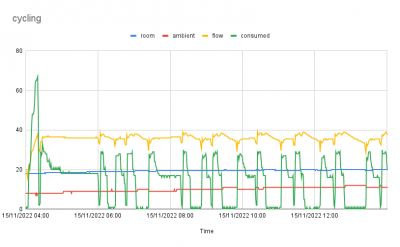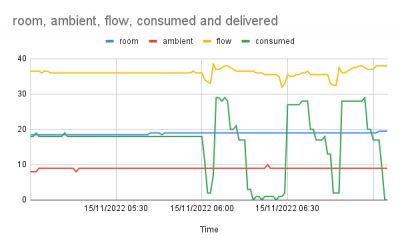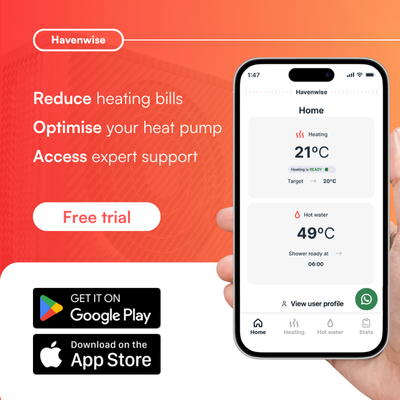Heat Pump Truth or Myth#2 - Cycling uses a lot of power and ruins your COP
Heat pump cycling is one of these topics where a lot of people seem to have an opinion but no actual data to back it up. Cycling is blamed a lot for poor ASHP performance and it seems to be generally accepted that cycling or even <gasp> short-cycling is a “Really Bad Thing”. I do have data so I decided to have a look at it.
This is a graph of my 14kW Ecodan over a few hours on a recent mild winter’s day.
After the morning startup, it runs for an hour or so without cycling. As the ambient rises it starts to cycle. And because cycling is a Really Bad Thing, it's now going to use more power and my COP will be really poor, right? Let’s see.
This is a comparison of two periods after the initial warm up; not cycling (5-6am) and cycling (6am-1pm)
|
time |
energy consumed Wh |
energy delivered Wh |
Ave Ambient deg |
average power consumed W |
average power delivered W |
ave flow temp |
COP |
|
5-6am |
1082 |
4246 |
8.9 |
1082 |
4246 |
36.1 |
3.9 |
|
6am-5pm |
6112 |
27578 |
10.3 |
777 |
3506 |
35.9 |
4.5 |
During the cycling period, the COP is better and the power consumed is less. Surely that can’t be right? That’s not meant to happen; the power used should be much more and the COP should have plummeted.
So what happened? Well what you’d expect really. The COP is better because it’s warmer outside and the average flow temp is nearly the same. The average power consumed is less because the heat demand is less and the COP is better. The bit that might be surprising, is that cycling hasn’t made a big difference to consumption or efficiency. Why not? I think it’s because the widely touted theory that starting up an ASHP and warming up the flow a bit uses an excessive amount of energy is a load of cobblers. There are no large peaks in power. And, at the risk of stating the bleeding obvious, between peaks there are troughs, empty ones.
I am sure the cycling does make some difference and a smaller ASHP delivering 3.5kW without cycling will do it a bit more efficiently. If I look at the next size of ASHP down from mine, it can modulate down to around 3.5kW and it looks to have a 10-15% better COP at this output than I got with my cycling. Let’s say 15%. That means that I’d be saving around 120W of power, or about £1 per day over 24 hours at today’s prices.
I know there is more to it than this and there are a lot more extreme examples of cycling out there but I think cycling sometimes gets a bit of a bum rap for being the cause of all heat pumps’ ills. And I’d rather have a heat pump that cycles a bit when it’s warmer and cheaper to run than be inside shivering when it’s freezing outside, the ASHP is defrosting every hour and running flat out trying to match the number on its badge.
I’d be interested if anyone else has done any similar analyses. Or even just has an opinion. 😉
Hi Kev,
Excellent data once more.
I am not certain where the claim that heat pumps use more energy and are less efficient when they cycle originated.
Maybe someone had noticed that their heat pump was cycling (defrosting) during cold weather, and was also using lots of power, so put two and two together.
Maybe the heat pump was operating with a fixed LWT of 55C or even 60C, so hence was running inefficiently when it was operating.
As you correctly stated, as the outside air temperature increases, your home's heat loss reduces, so your heat pump does not need to produce as much heat energy. The warmer outside air also contains more energy for the heat pump to extract, which in turn should improve efficiency, though the fact that the heat pump may be using more electrical energy when it first starts running may have a negative effect.
The fact that your system was operating under correctly adjusted weather compensation may also be of importance. When your heat pump starts running it quickly achieves the calculated LWT, so the compressor is not working hard and soon stabilises and operates in an efficient manner. If the calculated LWT was at a much higher value, it would take longer to stabilise which may prove less efficient. Without carrying out very detailed testing, it is difficult to state for certain.
I believe one of the reasons why 'short' cycling may be of concern is more to do with correct lubrication of the compressor when it is running repeatedly for short periods of time. Think of the additional wear that may be experienced by a car engine if it is repeatedly stopped and started without the lubricating oil getting up to temperature. I remember reading that one of the manufacturers stated that starting and stopping the heat pump more than 6 times in a 1 hour period was to be avoided.
Posted by: @kev-mThere are no large peaks in power.
Am I misreading your graph? It looks like "consumed" hits peaks every time it starts up.
Posted by: @kev-mAnd, at the risk of stating the bleeding obvious, between peaks there are troughs, empty ones.
Of course, so for cycling to be more efficient than not, the area of the trough would need to exceed the area under the peak above the steady state. Yours does not, so cycling is using more power than if you could avoid it, or at least lengthen the troughs to be bigger than the peaks. One of the frustrations with current heat pump programming is that most will do short off cycles up to a frankly absurd level of 6 an hour and make no attempt to lengthen the "off" periods on the third or later repeat. Although you may be still losing a small bit of efficiency compared with the ideal situation (pump modulates to a low enough output), your graph is nowhere near that bad an example of cycling.
Sadly, I've lost my data from the spring to a software/hardware failure (SD cards are not good backup devices... it now backs up to a USB disk) and didn't suffer any particularly bad cycling this autumn for various reasons (including the long mild spell and none of the control systems I tried were particularly vulnerable to cycling, reacting to the pump shutting down). In winter, the pump is working hard enough that short-cycling is rare. In summer, it's working so little that it's also rare.
Posted by: @mjrPosted by: @kev-mThere are no large peaks in power.
Am I misreading your graph? It looks like "consumed" hits peaks every time it starts up.
Posted by: @kev-mAnd, at the risk of stating the bleeding obvious, between peaks there are troughs, empty ones.
Of course, so for cycling to be more efficient than not, the area of the trough would need to exceed the area under the peak above the steady state. Yours does not, so cycling is using more power than if you could avoid it, or at least lengthen the troughs to be bigger than the peaks. One of the frustrations with current heat pump programming is that most will do short off cycles up to a frankly absurd level of 6 an hour and make no attempt to lengthen the "off" periods on the third or later repeat. Although you may be still losing a small bit of efficiency compared with the ideal situation (pump modulates to a low enough output), your graph is nowhere near that bad an example of cycling.
Sadly, I've lost my data from the spring to a software/hardware failure (SD cards are not good backup devices... it now backs up to a USB disk) and didn't suffer any particularly bad cycling this autumn for various reasons (including the long mild spell and none of the control systems I tried were particularly vulnerable to cycling, reacting to the pump shutting down). In winter, the pump is working hard enough that short-cycling is rare. In summer, it's working so little that it's also rare.
I remember reading in one of the manuals (don't ask me which) that the heat pump was prevented from restarting for a period of 10 minutes, which would reduce frequent cycling.
During the warmer periods when cycling is more prevalent, setting the system to operate under thermostat control should extend the running and none running periods, which should help reduce the cycling frequency.
Posted by: @mjrPosted by: @kev-mThere are no large peaks in power.
Am I misreading your graph? It looks like "consumed" hits peaks every time it starts up.
Posted by: @kev-mAnd, at the risk of stating the bleeding obvious, between peaks there are troughs, empty ones.
Of course, so for cycling to be more efficient than not, the area of the trough would need to exceed the area under the peak above the steady state. Yours does not, so cycling is using more power than if you could avoid it, or at least lengthen the troughs to be bigger than the peaks. One of the frustrations with current heat pump programming is that most will do short off cycles up to a frankly absurd level of 6 an hour and make no attempt to lengthen the "off" periods on the third or later repeat. Although you may be still losing a small bit of efficiency compared with the ideal situation (pump modulates to a low enough output), your graph is nowhere near that bad an example of cycling.
Sadly, I've lost my data from the spring to a software/hardware failure (SD cards are not good backup devices... it now backs up to a USB disk) and didn't suffer any particularly bad cycling this autumn for various reasons (including the long mild spell and none of the control systems I tried were particularly vulnerable to cycling, reacting to the pump shutting down). In winter, the pump is working hard enough that short-cycling is rare. In summer, it's working so little that it's also rare.
There are peaks but they are small and narrow. They are not using a lot of energy. I didn't say cycling wasn't less efficient; my point is that while cycling is less efficient than not cycling , the degree of inefficiency is (in this case anyway) small.
Posted by: @kev-mI didn't say cycling wasn't less efficient; my point is that while cycling is less efficient than not cycling , the degree of inefficiency is (in this case anyway) small.
And I also say your system is barely cycling in the example, so proves/disproves nothing.
Posted by: @mjrPosted by: @kev-mI didn't say cycling wasn't less efficient; my point is that while cycling is less efficient than not cycling , the degree of inefficiency is (in this case anyway) small.
And I also say your system is barely cycling in the example, so proves/disproves nothing.
Of course I haven’t proved or disproved anything with such an unscientific experiment. I think what I have done is show that when my heat pump has 15 starts in 7 hours, it doesn’t significantly worsen efficiency.
Another way of looking at it is to compare these two hours. They are delivering very similar amounts of heat in similar conditions in the same house, with the same settings. The only difference is that in the second hour the one the ASHP is cycling 3 times per hour (barely?) and in the second it isn’t. That's the most frequent cycling I can find on my ASHP btw.
|
time |
energy consumed Wh |
energy delivered Wh |
Ave Ambient deg |
average power consumed W |
average power delivered W |
ave flow temp |
COP |
|
5-6am |
1100 |
4318 |
8.9 |
1082 |
4247 |
8.9 |
3.9 |
|
6-7am |
1006 |
4429 |
9.0 |
929 |
4088 |
9.0 |
4.4 |
There is an interesting video on youtube from John Cantor (OpenEnergyMonitor and heatpumps.co.uk) driven off data in OpenEnergyMonitor (and presumably some investigations into performance). Effectively shot-cycling in itself is not necessarily too bad for performance (a few percent drop in performance, especially for more modern inverter driven compressors), although in the case of mis-use of a heat pump (timer, turning it off overnight) or incorrect sizing will still cause performance problems. The mention of buffer tanks, as well as a plumbing diagram with a plate heat exchanger, were interesting.
thanks for this, very interesting and (I think) broadly confirms what I said, but with a bit more rigour and credibility!
Old thread but it does address part of my question hence not creating a new one:
Does this mean that oversizing an ASHP isn't necessarily a terrible thing? My installer for some reason ignored my request for an 8.3kW Air-to-Air ASHP ('Aircon') and put in a 12kW Mitsu MXZ-F outdoor unit for 4 fan coil units (2x 2.5, 2x3.5). Of course the math seems to work out (2.5+2.5+3.5+3.5 = 12) but this is a passivhaus so it is super unlikely that all these FCUs would run at full tilt, let alone at the same time. So far I really have only been running one 2.5 fairly regularly, and the ASHP can only go down to 3.6kW....
The unit I was expecting (8.3) has other advantages, such as being meaningfully quieter and a bit more efficient (10% better) but on the downside, it has no option to add another FCU and I might just want to do so in the near future (one un-ACed room gets pretty hot..)
Thoughts? Spec sheet of ASHP attached.
I understand that A2A heat pumps have better turndown than A2W thus sizing is less critical. I haven't seen the proof that this is true however.
4kW peak of solar PV since 2011; EV and a 1930s house which has been partially renovated to improve its efficiency. 7kW Vaillant heat pump.
- 26 Forums
- 2,338 Topics
- 52.8 K Posts
- 544 Online
- 5,994 Members
Join Us!
Podcast Picks
Latest Posts
-
RE: Grant Aerona Short Cycling
@damonc this is a great little tool I have been using W...
By Grantmethestrength , 28 minutes ago
-
RE: Havenwise App Help & Forum Support – Get the Most from Your Heat Pump
@hcas Hello Henri. It is disappointing, but I must pres...
By DavidAlgarve , 3 hours ago
-

RE: What a Bad Heat Pump Installation Looks Like
@jamespa BBC Radio Four recently ran a week of programm...
By Toodles , 4 hours ago
-
RE: Home energy storage & battery register
I have Solax X1-AC with 5.8kWh. Last month we install...
By williamp , 6 hours ago
-
RE: Aira Heat Pump: Stylish Scandinavian Heating
Thanks @gmuzz @mikeh They still mention on the app t...
By ChandyKris , 10 hours ago
-
RE: Experience with Mitsu Par 50/60 Wireless Controller
The 27°C request doesn't boost the weather compensation...
By Sheriff Fatman , 1 day ago
-
RE: Getting the best out of a heat pump - is Homely a possible answer?
Oh and it was installed by Stevie Wonder!
By Grantmethestrength , 1 day ago
-
There seems to be plenty of evidence to support this. ...
By JamesPa , 1 day ago
-
RE: One Year Review: Grant 13kW ASHP - A Catalogue of Errors
@solenoid it sounds like you are making progress. No n...
By JamesPa , 1 day ago
-

RE: LiFePO4 lithium battery fires and explosions
@iaack — thanks, a useful video. They do make it clear...
By cathodeRay , 1 day ago
-
RE: How good is the app support for your heat pump?
I think you are right about the ebus stick. It's cert...
By JamesPa , 2 days ago
-

RE: My DIY Heat Pump installation
@majordennisbloodnok Element-ary my Dear Major.
By Toodles , 2 days ago
-
RE: Replacing my 18 month old Hitachi Yutaki ASHP
Yes, you can work out a lot from a plot of FT. Interes...
By JamesPa , 2 days ago
-

Welcome to the forums @isaac. What you’re describing is...
By Mars , 2 days ago
-

Win an Eve Smart Home Bundle worth over £350!
Win an Eve Smart Home Bundle worth over £350! ...
By Mars , 2 days ago
-
RE: Is your heat pump insured?
I chose Tesco in the end. Unambiguously cover HP, PV an...
By Davesoa , 3 days ago
-
RE: Help me keep the faith with my air source heat pump installation
@adamk You can get an idea of if your flow and return...
By SimonF , 3 days ago
-
This Solis inverter being rated 8kw and (I expect, as I...
By Batpred , 3 days ago








